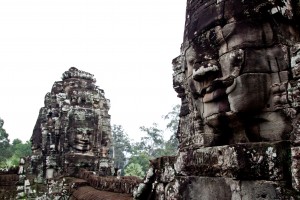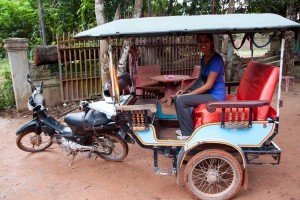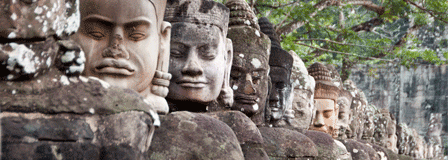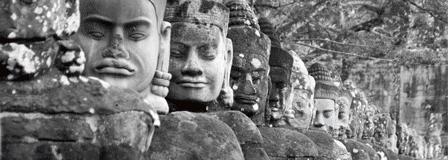Angkor What?!
Once again, Tyler and I found ourselves in a place that leaves you speechless – that completely exceeds the hype – that demands introspection upon inspection – that inspires architectural awe and fills you with wonder. The serenity, splendor, and spirituality of Angkor Wat and surrounding temples is well-known and documented, but is something to experience firsthand. We were lucky to have an overcast misty day to keep us cool-ish (still 90+) and to add to the mysterious aura surrounding the buildings.
 First, a little education. Angkor Archaeological Park contains the magnificent remains of the different capitals of the Khmer Empire, from the 9th to the 15th century. Angkor Wat refers to one specific temple/capital (the most famous and the symbol on Cambodian money and its flag), but there are actually MANY temple complexes in this region just outside Siem Reap. Angkor Wat is the largest Hindu temple complex in the world and was built in the early 1100’s. Its inception was in Hinduism but it was transformed into a Buddhist temple when a later King converted (along with most Cambodians). Let it be noted it was a peaceful transition, even when it went back to Hinduism for a time. I will not even pretend to highlight for you the deep historical, religious, archeological, architectural, cultural, and spiritual significance of Angkor – I’m not capable of the task. But I do encourage you to read more about it (for instance on the UNESCO world heritage website) and to really make an effort to visit. It is a true highlight of the world that can only be appreciated and understood in person.
First, a little education. Angkor Archaeological Park contains the magnificent remains of the different capitals of the Khmer Empire, from the 9th to the 15th century. Angkor Wat refers to one specific temple/capital (the most famous and the symbol on Cambodian money and its flag), but there are actually MANY temple complexes in this region just outside Siem Reap. Angkor Wat is the largest Hindu temple complex in the world and was built in the early 1100’s. Its inception was in Hinduism but it was transformed into a Buddhist temple when a later King converted (along with most Cambodians). Let it be noted it was a peaceful transition, even when it went back to Hinduism for a time. I will not even pretend to highlight for you the deep historical, religious, archeological, architectural, cultural, and spiritual significance of Angkor – I’m not capable of the task. But I do encourage you to read more about it (for instance on the UNESCO world heritage website) and to really make an effort to visit. It is a true highlight of the world that can only be appreciated and understood in person.
Logistics on the temple tour. We had a private tuk-tuk driver and english-speaking guide for the day. You could probably do without a guide if you really educated yourself beforehand and brought good maps/books, but we like having guides so we splurged. We only spent 1 day exploring the temples, but there are SO many- you should probably spend 3 and could easily spend 7. We did wake up ridiculously early to catch sunrise over Angkor Wat Temple, but it was rainy and very overcast, so the wake-up was a bust. It was still worth it though – very nice to be in the park before the crowds swelled later in the day. Also, the stairs to the top of the Angkor Wat Temple were open on our visit (sometimes they’re not, esp. near holiday times), so we were able to climb up and get an amazing view of the complex and countryside. There is food and random trinkets for sale, and you will see some particularly diligent child hawkers, but we’d recommend bringing your own water/snacks. Pet Peeve: DO NOT call the Ta Prohm temple the “tomb raider movie temple” – yes, part of the movie was filmed there, but it was kind-of-important before Angelina Jolie made an appearance. Most importantly, don’t miss the “unfinished temple” – aka the unlucky temple – it was actually one of our favorites and is often over-looked by guides because Asian visitors (stereotype: Asians are superstitious) hate the name. It is unlucky because it was struck by lightning during building, so the King ordered it to be abandoned. How a stone structure was struck by lightning is a bit eyebrow-raising, but it’s magnificent in its unfinished bastardization. Do make sure to walk around the forest areas – it’s so lush, beautiful, and very serene.
Siem Reap is the Cambodian city closest to Angkor and thus the tourist capital of the country. We stayed at the lovely Wooden Angkor Hotel with its no-shoes policy and ridiculously attentive staff. It was 5-star luxury at Motel 6 price, and we were happy to use it as a base to explore the area. The town is full of friendly locals trying to make money from their tourist-industry businesses, and we were happy to oblige a few massage salons, restaurants, travel agents, and tuk-tuk drivers. For a tourist town, it is VERY cheap, and people work very hard for their money. Tipping isn’t required or even customary, but we always do, and it goes a very long way here. We also visited the modern and educational Angkor National Museum, which at $12/person entrance fee is a bit steep, but well worth it. The museum is home to an inordinate number of artifacts from the Park including a room of 1000 Buddhas. It also explains much of the history of the Khmer Empire – kings, religions, wars – and we would recommend visiting the museum prior to visiting the Park .
 The other common “excursion” from Siem Reap is to visit a floating village. I have wanted to do visit this type of village for years, but now that I have, I have mixed feelings about the whole experience. You take a tuk-tuk/car out of SR for almost an hour into the rural countryside of Cambodia, which in and of itself is a wonderful experience. We recommend tuk-tuk because you really get the full experience with the smells and kids chasing after you waving and saying HELLO in the most adorable voices ever (really, all they ever want is for Tyler to wave at them back and say hello! Me, they could care less). Not only do you get to see the green gorgeous landscape, but the way people live in these rural parts, outhouses, mud huts, and all. Then you get to the water – Tonle Sap Lake. There are a number of floating villages and some are more visited than others. We visited the floating village and floating forest of Kompong Phluk, and it really is a bizarre sight. Houses, schools, government buildings, temples, even the occasional guesthouse and restaurant all on the water – either as a stand-alone floating contraption or built on very high stilts. And an entire dense forest, in the water (during rainy season, of course). Kids get to school via boat (which they row themselves, even at the age of 4). As a tourist, you are literally driven through on an obnoxiously loud, pollution-causing boat and “observe” life like you’re looking at some form of wildlife on safari. It’s weird. So though I’m very glad we did get to see this completely alternate lifestyle in person, I don’t know that I’d recommend it to anyone really. It just felt so… invasive. And, well, rude. Certainly the communities make some money off these tours and you can certainly stop at a restaurant and get some food (but please don’t eat the fish from the lake- so contaminated – partially because of the tourist boats!), but I can’t imagine the money they receive makes up for the added pollution to their home/food source. If I could go back in time, I’d at least take some school books or supplies to donate.
The other common “excursion” from Siem Reap is to visit a floating village. I have wanted to do visit this type of village for years, but now that I have, I have mixed feelings about the whole experience. You take a tuk-tuk/car out of SR for almost an hour into the rural countryside of Cambodia, which in and of itself is a wonderful experience. We recommend tuk-tuk because you really get the full experience with the smells and kids chasing after you waving and saying HELLO in the most adorable voices ever (really, all they ever want is for Tyler to wave at them back and say hello! Me, they could care less). Not only do you get to see the green gorgeous landscape, but the way people live in these rural parts, outhouses, mud huts, and all. Then you get to the water – Tonle Sap Lake. There are a number of floating villages and some are more visited than others. We visited the floating village and floating forest of Kompong Phluk, and it really is a bizarre sight. Houses, schools, government buildings, temples, even the occasional guesthouse and restaurant all on the water – either as a stand-alone floating contraption or built on very high stilts. And an entire dense forest, in the water (during rainy season, of course). Kids get to school via boat (which they row themselves, even at the age of 4). As a tourist, you are literally driven through on an obnoxiously loud, pollution-causing boat and “observe” life like you’re looking at some form of wildlife on safari. It’s weird. So though I’m very glad we did get to see this completely alternate lifestyle in person, I don’t know that I’d recommend it to anyone really. It just felt so… invasive. And, well, rude. Certainly the communities make some money off these tours and you can certainly stop at a restaurant and get some food (but please don’t eat the fish from the lake- so contaminated – partially because of the tourist boats!), but I can’t imagine the money they receive makes up for the added pollution to their home/food source. If I could go back in time, I’d at least take some school books or supplies to donate.
That pretty much sums up our time Siem Reap. I was planning to wax philosophical about my Hindu upbringing and the impact seeing Angkor Wat had on me, but to be honest, I’m still sorting it out in my head. I will say I was moved, perhaps more powerfully than ever before, in a desire to really push myself, spiritually. But there’s too much dogmatic nonsense that comes with organized religion that I still can’t get behind, so for now, lets just say I’d like to learn how to better incorporate the life philosophies that Hinduism teaches into my everyday life.


